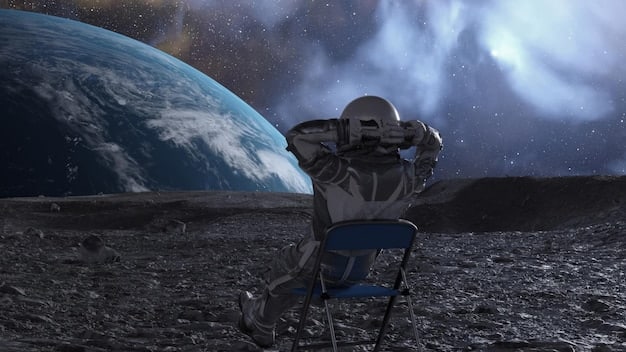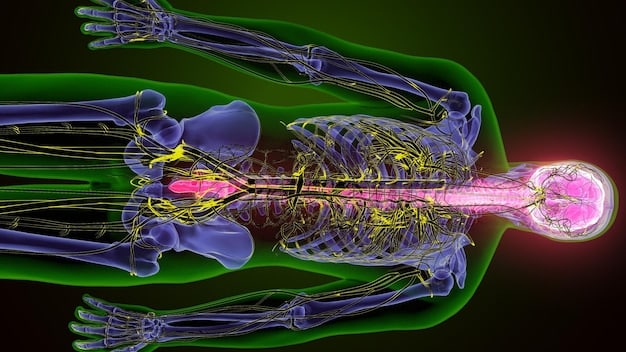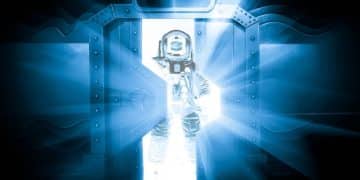Mitigating Health Risks of Long-Duration Space Travel: US Research by 2028

What are the potential health risks associated with long-duration space travel, and how are US researchers working to mitigate them by 2028? Prolonged space missions pose significant health challenges, including bone loss, muscle atrophy, radiation exposure, and psychological stress. US researchers are actively developing countermeasures such as exercise protocols, advanced shielding technologies, and telemedicine solutions to reduce these risks and ensure astronaut safety by 2028.
The allure of exploring distant worlds has captivated humanity for generations. However, what are the potential health risks associated with long-duration space travel, and how are US researchers working to mitigate them by 2028? The journey beyond Earth’s protective embrace presents a unique set of challenges to the human body.
Understanding these risks and developing effective countermeasures are crucial steps toward making long-duration space missions a reality, paving the way for human exploration of the solar system and beyond. Let’s delve into the specific health risks and the cutting-edge research underway to address them.
Understanding the Physiological Challenges of Space
Space travel imposes a unique set of stressors on the human body. The absence of gravity, exposure to radiation, and the confined environment all contribute to a variety of physiological challenges that can impact an astronaut’s health and well-being.
The Impact of Microgravity
One of the most significant challenges of space travel is microgravity, also known as weightlessness. This lack of gravitational force has profound effects on the musculoskeletal system, cardiovascular system, and sensorimotor system.
- Bone Loss: In microgravity, bones are no longer subjected to the same weight-bearing forces as on Earth, leading to a decrease in bone density. Astronauts can lose up to 1-2% of their bone mass per month in space.
- Muscle Atrophy: Similar to bones, muscles also weaken in microgravity. The reduced need for muscle strength to perform everyday tasks results in muscle atrophy, particularly in the legs and back.
- Cardiovascular Changes: The cardiovascular system adapts to the absence of gravity by redistributing fluids towards the upper body. This can lead to changes in heart size, blood volume, and blood pressure regulation.

To combat these effects, astronauts follow rigorous exercise protocols while in space, using resistance machines and other equipment to simulate the effects of gravity and maintain bone and muscle mass. Further research focuses on pharmacological interventions and personalized exercise programs to optimize astronaut health.
Radiation Exposure and its Consequences
Beyond Earth’s protective atmosphere and magnetic field, astronauts are exposed to significantly higher levels of radiation than they would experience on the planet’s surface. This radiation comes from various sources, including solar flares and cosmic rays.
The Risks of High-Energy Particles
Exposure to high-energy particles can damage DNA and increase the risk of cancer. It can also lead to other health problems, such as cataracts, cardiovascular disease, and neurodegenerative disorders. Understanding the effects of different types of radiation and developing effective shielding technologies are critical areas of research.
Researchers are investigating various materials and designs for spacecraft shielding. These shields can deflect or absorb radiation, protecting astronauts from harmful exposure. Additionally, studies are underway to identify biomarkers that can predict an individual’s susceptibility to radiation damage, allowing for personalized radiation protection strategies.
Furthermore, **what are the potential health risks associated with long-duration space travel, and how are US researchers working to mitigate them by 2028** in terms of radiation? Pharmaceutical countermeasures are also being explored to mitigate the harmful effects of radiation exposure, such as antioxidants and DNA repair enzymes.
Monitoring Radiation Levels
Continuous monitoring of radiation levels is essential to ensure astronaut safety. Spacecraft equipped with radiation detectors provide real-time data on the radiation environment, allowing mission controllers to make informed decisions about crew activities and spacecraft positioning.
- Real-time Data: Spacecraft are equipped with radiation detectors to provide real-time data.
- Informed Decisions: Mission controllers making informed decisions concerning radiation exposure.
- Crew Safety: Protecting the astronaut crew.
Ultimately, these research endeavors contribute significantly to our understanding of the complexities of radiation exposure in space and directly inform strategies designed to minimize the associated risks faced by astronauts during long-duration missions.
Psychological and Cognitive Impacts of Isolation
Long-duration space missions involve prolonged periods of isolation and confinement, which can have significant psychological and cognitive impacts on astronauts. Mental health is just as crucial as physical health in ensuring mission success.

Addressing Mental Well-being in Space
Astronauts can experience a range of psychological challenges, including stress, anxiety, depression, and sleep disturbances. These challenges can be exacerbated by the lack of natural light, the disruption of circadian rhythms, and the limited social interaction.
Telemedicine and virtual reality technologies are being used to provide astronauts with remote access to mental health professionals and to create immersive environments that simulate familiar surroundings. These interventions can help astronauts cope with stress, maintain social connections, and promote psychological well-being.
Moreover, understanding **what are the potential health risks associated with long-duration space travel, and how are US researchers working to mitigate them by 2028** also involves understanding the psychological impact on astronauts.
Cognitive Performance in Extreme Environments
Cognitive performance can also be affected by the stressors of space travel. Astronauts need to maintain sharp decision-making skills, problem-solving abilities, and situational awareness to perform their tasks effectively.
- Decision-making: Critical operational tasks on the space station.
- Problem-solving: Essential for maintenance and repairs.
- Situational awareness: Responding to unexpected events.
Researchers are developing cognitive training programs and monitoring strategies to assess and improve cognitive function in astronauts. These programs can help astronauts maintain their mental acuity and perform at their best, even in the challenging environment of space.
Nutritional Considerations for Extended Missions
Maintaining optimal nutrition is essential for astronaut health and performance during long-duration space missions. Meeting the unique nutritional needs of astronauts in space requires careful planning and innovative approaches.
The Importance of a Balanced Diet
Astronauts need a balanced diet that provides adequate amounts of calories, protein, vitamins, and minerals. Meeting these nutritional requirements can be challenging due to the limited storage space on spacecraft and the effects of microgravity on food preparation and consumption.
Researchers are developing advanced food processing and packaging techniques to create shelf-stable, nutrient-rich foods that can be easily prepared and consumed in space. They are also investigating the use of hydroponic systems to grow fresh produce on spacecraft, providing astronauts with a source of vitamins and minerals.
In addition to physical health, **what are the potential health risks associated with long-duration space travel, and how are US researchers working to mitigate them by 2028**, nutrition can also help by addressing common issues in space, such as bone loss and immunity.
Personalized Nutrition Plans
Individual nutritional needs can vary depending on factors such as age, gender, and medical history. Personalized nutrition plans can help astronauts optimize their nutrient intake and maintain their health and performance throughout the mission.
These plans are based on detailed assessments of an astronaut’s metabolic needs and dietary preferences. They also take into account the availability of different food items and the potential for nutrient degradation during long-term storage.
The Role of Exercise in Maintaining Health
Regular exercise is a cornerstone of maintaining astronaut health during long-duration space missions. Exercise helps to counteract the negative effects of microgravity on the musculoskeletal and cardiovascular systems.
Implementing Effective Exercise Regimens
Astronauts follow rigorous exercise protocols that incorporate both resistance training and aerobic exercise. These exercise regimens help to maintain bone density, muscle mass, and cardiovascular fitness.
Researchers are continually refining exercise protocols to optimize their effectiveness and to make them more personalized to individual astronaut needs. They are also developing new exercise equipment that is more compact, versatile, and user-friendly.
Therefore, to counteract conditions like muscle loss and bone density issues, **what are the potential health risks associated with long-duration space travel, and how are US researchers working to mitigate them by 2028**? Exercise is key.
Monitoring Exercise Performance
Monitoring exercise performance is essential to ensure that astronauts are achieving their fitness goals and to identify any potential problems. This monitoring can involve tracking heart rate, oxygen consumption, and muscle strength.
- Heart Rate: Tracking cardiovascular health in real-time.
- Oxygen Consumption: Monitoring metabolic performance.
- Muscle Strength: Assesing the effectiveness of exercise.
Data from exercise monitoring can be used to adjust exercise protocols and to provide astronauts with individualized feedback. It can also help to detect early signs of overtraining or injury.
| Key Area | Brief Description |
|---|---|
| 💪 Muscle Atrophy | Microgravity leads to muscle weakening. |
| 🦴 Bone Loss | Bones lose density due to lack of weight-bearing. |
| 🛡️ Radiation Exposure | Astronauts face high radiation levels. |
| 🧠 Psycho Impacts | Isolation affects mental well-being. |
Frequently Asked Questions
The main physical health risks include bone loss, muscle atrophy, cardiovascular issues, and radiation exposure, all compounded by the effects of microgravity over extended periods.
Space radiation can damage DNA, increasing the risk of cancer, cataracts, and other health problems. Shielding and monitoring are used to mitigate these effects.
Astronauts face isolation, stress, anxiety, and sleep disturbances. Researchers are developing telemedicine and cognitive support for their mental well-being.
Proper nutrition is essential to counteract muscle atrophy, boost immunity, and maintain energy. Personalized plans are created to meet each astronaut’s needs.
Regular exercise helps counteract bone loss, muscle atrophy, and cardiovascular issues. Personalized exercise protocols are designed to fit astronaut needs.
Conclusion
Addressing the health risks associated with long-duration space travel is paramount for ensuring the safety and well-being of astronauts venturing beyond Earth. The research efforts undertaken by US scientists play a crucial role in identifying, understanding, and mitigating these health challenges.
As we move closer to realizing ambitious space exploration goals, continued investment in research and the development of effective countermeasures will be essential. By proactively addressing what are the potential health risks associated with long-duration space travel, and how are US researchers working to mitigate them by 2028?, we can unlock the full potential of human space exploration while ensuring the health and safety of those who dare to explore the cosmos.





